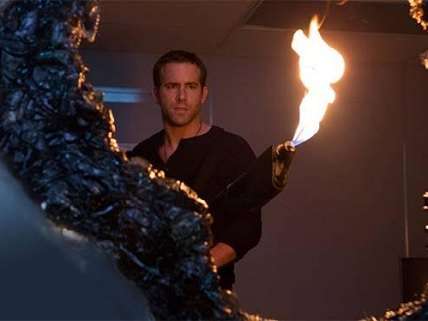Movie Review: Self/Less
Ben Kingsley trades up to Ryan Reynolds' body, with muddled results.


The new sci-fi movie Self/Less poses a pressing question: why did Tarsem Singh want to make this picture? Singh, the director who demonstrated such a spectacular visual gift in films like The Cell (2000) and especially The Fall (2006), here delivers a movie that looks as if it were shot, by turns, in an auto showroom, an ICU ward, and a grassy field. There are also a few deluxe environments (New York's Four Seasons restaurant, the peerlessly garish Trump Tower hotel), but the director presents them as-is, with none of the surreal fantasy embellishments of which he's capable. The picture is a waste of his talent and our time.
This is a body-swap movie just barely unlike the old John Frankenheimer film Seconds. The premise is still intriguing. Damian Hale (Ben Kingsley), a real-estate mogul dying of cancer, is given the business card of a company called Phoenix Biogenix, which, for a hefty price, will transfer Hale's consciousness into a healthy young body created in the Phoenix lab. The company's CEO, a chilly character named Albright (Matthew Goode), depicts this trans-human undertaking as a service to humanity: "Just think of all the great minds we've lost, just because their bodies failed them."
But wait a minute. How does a cut-throat businessman like Hale qualify as a "great mind"? And why would a company as secretive as Phoenix be in the habit of handing out business cards? These are puzzles that go unaddressed. But we play along, and it's fun for awhile.
Hale is dispatched to New Orleans, where he fakes his own death and is then wheeled into an OR where, after some spinning-light effects, he wakes up in the body of Ryan Reynolds. Not a bad deal. There is a slight problem: violent hallucinations in which the face of a little girl figures. But Albright produces a bottle of red pills that he says will keep these mental eruptions under control.
The former Damian Hale is then given a new name (Eddie) and a new backstory, with accompanying ID and cash-packed bank account. He is installed in a new life, which includes a fabulous mansion and top-of-the-line sports car. He begins picking up chicks in the company of a mysterious new friend named Anton (Derek Luke). Life is good again.
But then another hallucination breaks through, with enough visual information to lead Eddie to a small house in St. Louis, where he encounters a woman named Madeline (Natalie Martinez) and the little girl of Eddie's tumultuous dreams. Just as he's figuring out what's really going on, the house is attacked by heavily armed Phoenix operatives, who've had Eddie under surveillance.
Here, Singh makes the mistake of trying to turn the story away from sci-fi speculation and into an action movie, a genre for which he has no special facility. There's an awful lot of fighting and shooting and flame-throwing, but those things alone, unenhanced by imaginative staging and energetic editing, do not constitute "action," only noise. There's also a long car-chase sequence into which a lot of effort was surely put, but it's nevertheless generic.
As Eddie (or Mark, as he's now called, having sustained a second name-change) makes his way back toward a big-reveal confrontation with Albright, we ponder the movie's other problems. Why does Reynolds' character, a dull fellow, share no colorful residual traits with the departed Damian Hale? Why is the headquarters of Phoenix—a company that charges $250-million per body job—located in a warehouse used for storing Mardi Gras floats? And why did Singh and his sibling writers, David and Àlex Pastor, feel the need to stir in a wispy subplot, of minimal interest, involving Hale's estranged daughter (Michelle Dockery, of Downton Abbey)? None of these questions are resolved. But then by the end, we've lost interest in asking them.


Show Comments (19)